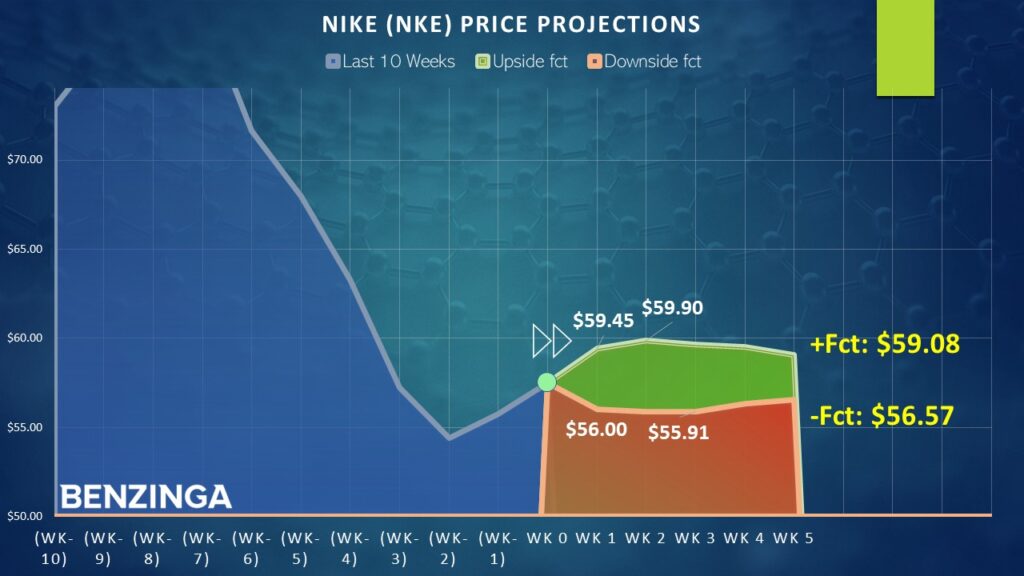Zinger Key Points
- Athletic apparel giant Nike looks awfully tempting to retail investors thanks to its poor market performance.
- The big money players aren’t buying it but are instead sellers of the NKE stock narrative.
- China’s new tariffs just reignited the same market patterns that led to triple- and quadruple-digit wins for Matt Maley. Get the next trade alert free.
At first glance, athletic apparel giant Nike Inc NKE appears to be a compelling discount, down roughly 25% from the start of the year. Additionally, NKE stock plunged about 39% over the past 52 weeks, a stunning fall from grace. Since peaking in late 2021, NKE stock has struggled to sustain positive momentum. Subsequently, the value erosion offers a contrarian entry point — but investors should be cautious.
Certainly, the upside thesis deserves careful consideration. Among covering analysts, none are bearish and quite a few are bullish. The problem, though, is that a majority of experts are indifferent to NKE stock. Undeniably, the company commands an enviable brand, resulting in a massive global footprint and strong margins relative to the industry. However, a decline in sales growth, especially compared to rivals, and a higher-than-average debt-to-equity ratio stand out as potential headwinds.
And those margins? While strong, the BBC pointed out that after accounting for total costs of business operations, Nike's profit margin shrinks to about 11%. Throw in the Trump administration's trade policies and the economic strain that American consumers are feeling and the longer-term prospects for NKE stock don't look so rosy anymore.
Conspicuously, then, investors need to pay close attention to Benzinga's options scanner, which recently identified bearish activity in the derivatives market. Specifically, the line item that popped is the bought puts expiring Dec. 17, 2027, with a strike price of $50. With a volume reading of 2,200 contracts against 329 contracts in open interest, this transaction suggests that new positions have been opened.
Also, the purchasing of puts necessarily means it's a debit transaction, as the position starts from a cash outflow position. By logical deduction, the underlying security must cross the transactional breakeven point to be profitable.
There's no other way for a debit option play to be successful — and that doesn't translate to great vibes for NKE stock.
Recognizing The Sentiment Cycle Of NKE Stock Before Taking The Plunge
Ultimately, the decision to buy, sell or avoid NKE stock will come down to personal risk tolerance. But before taking the plunge, investors should consider the empirical sentiment cycle of the security. Here, the traditional methodology of analysis falls into the trap of attempting to predict price with price. Instead, one can only practically predict price from patterns.
The harsh, dirty secret about many, if not most, technical analysis and momentum models is that they usually arrive at two basic conclusions: because the price has risen, it will continue to rise, or, failing that, because it's oversold, it might bounce.
Price being an infinite continuum of possibilities (at least to the upside), it's impossible to take this continuous scalar signal and assign concrete, categorizable labels. In other words, it's logically spurious to declare a good time to buy a stock unless there is a definition for what a “good stock price” is.
To get around this problem, investors can deploy a discrete-event analysis, essentially converting the language of continuous signals (i.e. price) into the language of defined, discrete events or patterns. Using a quasi-binary code of 33 categorizable strings, NKE stock in the past two months is currently riding a "4-6" sequence: four weeks of upside interspersed with six weeks of downside, with a negative trajectory across the 10 weeks.
To clarify, there's nothing inherently special about the 4-6 sequence by itself as sequences are byproducts of the systems they fall under. But the takeaway is that the 4-6 is objectively quantifiable and categorizable — and most importantly from a predictability standpoint, this and other patterns recur.

Over the past decade, the 4-6 sequence with a negative trajectory has yielded a long success ratio in the subsequent week of only 38.36%. Now, it's on pace to achieve a 5-5 sequence with a negative trajectory next week. However, this sequence historically only features a one-week success ratio of just under 49%.
The baseline odds that a long position entered at the beginning of the week will be profitable by the end is about 51.4%. Therefore, in the current sentiment cycle, the deck is stacked against the bulls.
An Aggressively Skeptical Trade For Nike
Given prior recurring patterns combined with bearish options activity amid a net negative environment for the consumer, aggressive traders may consider a bear put spread strategy, specifically targeting the 57/56 spread that expires May 9. This transaction involves buying the $57 put and simultaneously selling the $56 put, for a net debit of $48, at time of writing.
Should NKE stock fall through the $56 short strike price target at expiration, the maximum reward comes out to $52, or a payout of over 108%. Market makers don't anticipate such an outcome; hence, the high payout.
If the negative scenario pans out, NKE stock is likely to fall to around $55.91 over the next three weeks based on median trends. However, the risk to the upside may be an attempt to knock out the $60 level, a potential target due to its status as a psychological milestone.
Photo: Shutterstock
Edge Rankings
Price Trend
© 2025 Benzinga.com. Benzinga does not provide investment advice. All rights reserved.
Trade confidently with insights and alerts from analyst ratings, free reports and breaking news that affects the stocks you care about.